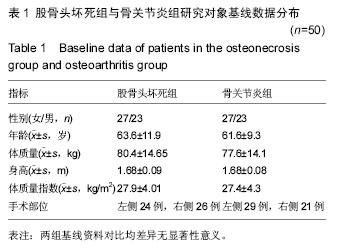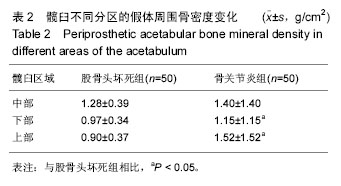| [1] 刘英飞,王涛,张平德.人工髋关节置换后的股骨假体周围骨折[J].中国组织工程研究, 2013,17(30):5557-5562.
[2] 张建林,赵俊华,叶军,等.人工髋关节假体材料磨损性能及其影响因素[J].中国组织工程研究,2010,14(22): 4082-4085.
[3] 安明勋.人工髋关节假体的设计及界面应力分析[J].中国组织工程研究,2012,16(30):5634-5638.
[4] 熊高鑫,黄彰,江华.人工髋关节置换中股骨假体周围骨折影响因素及相关分析[J].实用医学杂志,2012,28(9): 1504-1506.
[5] 孟东方,李慧英,阮志磊,等.淫羊藿对激素性股骨头坏死兔模型血钙血磷的影响[J].中医学报,2015,30(4):545-547.
[6] 李军伟,李鑫,王义生,等.股方肌蒂骨柱加钛网伞状支撑术治疗酒精性股骨头坏死 5 年随访研究[J].中华骨科杂志, 2015,35(8):787-794.
[7] 吴兴净,张永涛,郭雄,等.miR-125a-3p和miR-17-5p在激素性股骨头坏死中的作用[J].西安交通大学学报:医学版, 2015,36(2):210-214.
[8] 赵德伟.股骨头缺血性坏死的微创手术与显微修复[J].中华显微外科杂志,2015,38(3):209-210.
[9] Gao YH, Li SQ, Wang YF, et al. Arthroplasty in patients with extensive femoral head avascular necrosis. Int Orthop. 2015:1-5.
[10] Park YS, Moon YW, Lee KH, et al. Revision hip arthroplasty in patients with a previous total hip replacement for osteonecrosis of the femoral head. Orthopedics. 2014;37(12):1058-1062.
[11] Carter Y, Suchorab JL, Thomas CDL, et al.Normal variation in cortical osteocyte lacunar parameters in healthy young males. J Anat. 2014;225(3):328-336.
[12] Albanese CV, Santori FS, Pavan L, et al. Periprosthetic DXA after total hip arthroplasty with short vs.ultra-short custom-made femoral stems. Acta Orthop. 2009;80(3): 291-297.
[13] Pierce TP, Elmallah RK, Jauregui JJ, et al. Outcomes of total hip arthroplasty in patients with osteonecrosis of the femoral head-a current review. Cur Rev Musculoskel Med. 2015;8(3):246-251.
[14] Suksathien Y, Suksathien R, Chaiwirattana P. Acetabular cup placement in navigated and non-navigated total hip arthroplasty (THA): results of two consecutive series using a cementless short stem. J Med Assoc Thai. 2014;97(6):629-634.
[15] Tripuraneni KR, Munson NR, Archibeck MJ, et al. Acetabular abduction and dislocations in direct anterior vs posterior total hip arthroplasty: a retrospective, matched cohort study. J Arthroplasty. 2016.
[16] Friedrich MJ, Gravius S, Schmolders J, et al. Biological acetabular defect reconstruction in revision hip arthroplasty using impaction bone grafting and an acetabular reconstruction ring. Oper Orthop Traumatol. 2014;26(2):126-140.
[17] Zahar A, Papik K, Lakatos J, et al. Total hip arthroplasty with acetabular reconstruction using a bulk autograft for patients with developmental dysplasia of the hip results in high loosening rates at mid-term follow-up. Int Orthop. 2014;38(5):947-951.
[18] Hayashi S, Hashimoto S, Kanzaki N, et al. Daily activity and initial bone mineral density are associated with periprosthetic bone mineral density after total hip arthroplasty. Hip Int. 2016;26(2):169-174.
[19] Mann T, Eisler T, Bodén H, et al. Larger femoral periprosthetic bone mineral density decrease following total hip arthroplasty for femoral neck fracture than for osteoarthritis: A prospective, observational cohort study. J Orthop Res. 2015;33(4):504-512.
[20] Inaba Y, Kobayashi N, Oba M, et al. Difference in postoperative periprosthetic bone mineral density changes between three major designs of uncemented stems: a 3-year follow-up study. J Arthroplasty. 2016.
[21] Tapaninen T, Kröger H, Venesmaa P. Periprosthetic BMD after cemented and uncemented total hip arthroplasty: a 10-year follow-up study. J Orthop Sci. 2015;20(4):1-6.
[22] Keshmiri A, Schröter C, Weber M, et al. No difference in clinical outcome, bone density and polyethylene wear 5–7 years after standard navigated vs. conventional cementfree total hip arthroplasty. Arch Orthop Trauma Surg. 2015;135(5):723-730.
[23] Tingart M, Beckmann J, Opolka A, et al. Analysis of bone matrix compositionand trabecular microarchitecture of the femoral metaphysis in patients withosteonecrosis of the femoral head. J Orthop Res. 2009;27:1175-1181.
[24] Brice H, Farrant JP, Fowler SJ, et al. P236 relationship between bone mineral density and bone turnover markers in severe asthma patients on systemic corticosteroids. Thorax. 2014;69(Suppl 2):A180-A181.
[25] Alsabbagh M, Robinson FG, Romanos G, et al. Osteoporosis and bisphosphonate-related osteonecrosis in a dental school implant patient population. Implant Dent. 2015;24(3):328-332.
[26] Zhao DW, Yu XB. Core decompression treatment of early-stage osteonecrosis of femoral head resulted from venous stasis or artery blood supply insufficiency. J Surg Res. 2014;194(2):614-621.
[27] Hube R, Dienst M, Von R P.[Complications after minimally invasive total hip arthroplasty. Der Orthop. 2014;43(1):47-53.
[28] Blake GM, Fogelman I. An update on dual-energy x-ray absorptiometry. Semin Nucl Med. 2010;40(1): 62-73.
[29] Hakulinen MA, Borg H, Häkkinen A, et al. Quantification of bone density of the proximal femur after hip resurfacingarthroplasty-comparison of different DXA acquisition modes. J Clin Densitom. 2010;13:426-432.
[30] Sabo D, Reiter A, Simank HG, et al. Peripros-thetic mineralization around cementless total hip endoprosthesis: longitudinalstudy and cross-sectional study on titanium threaded acetabular cup andcementless spotorno stem with DEXA. Calcif Tissue Int. 1998;62:177-182.
[31] 孔令懿,马毅民,王倩倩等.定量CT测量髋关节骨密度的重复性与DXA 测量的一致性[J].中华骨质疏松和骨矿盐疾病杂志,2013,6(4):334-339.
[32] 常冰岩,卢勇,宋丽俊,等.DXA骨密度检测在骨质疏松症诊断、预防、治疗中的指导作用[J].中国骨质疏松杂志,2011, 17(2):153-157.
[33] Goodman SB, Hwang K, Imrie S. High complication rate in revision total hip arthroplasty in juvenile idiopathic arthritis. Clin Orthop Relat Res. 2014;472(2): 637-644.
[34] Gruen TA, Poggie RA, Lewallen DG, et al. Radiographic evaluation of amonoblock acetabular component: a multicenter study with 2- to 5-year results. J Arthroplasty. 2005;20:369-378.
[35] El Maghraoui A, Roux C. DXA scanning in clinical practice. QJM. 2008;101:605-617. |
.jpg)


.jpg)
.jpg)